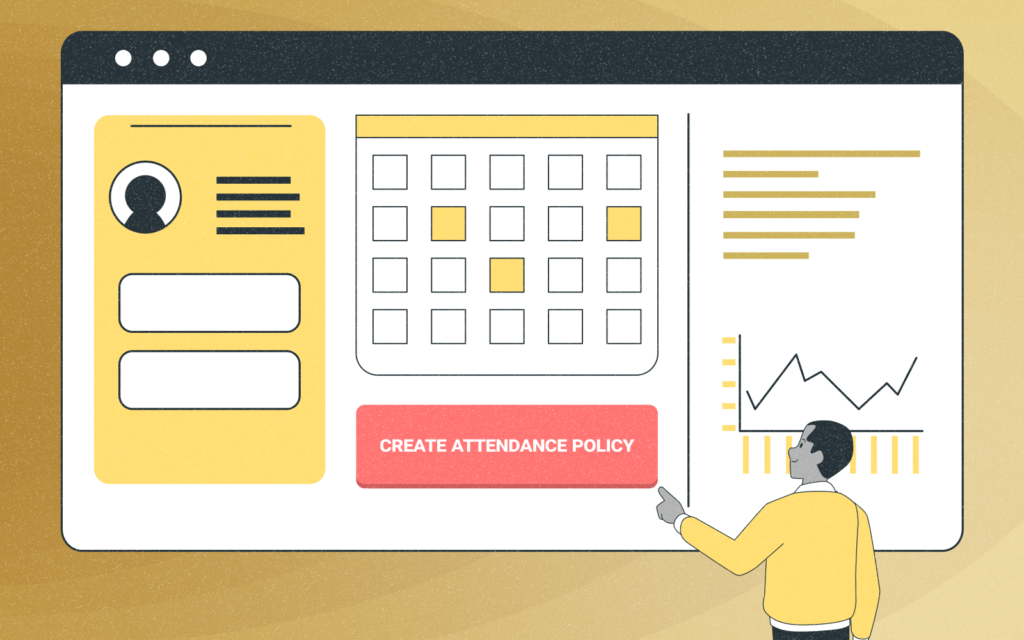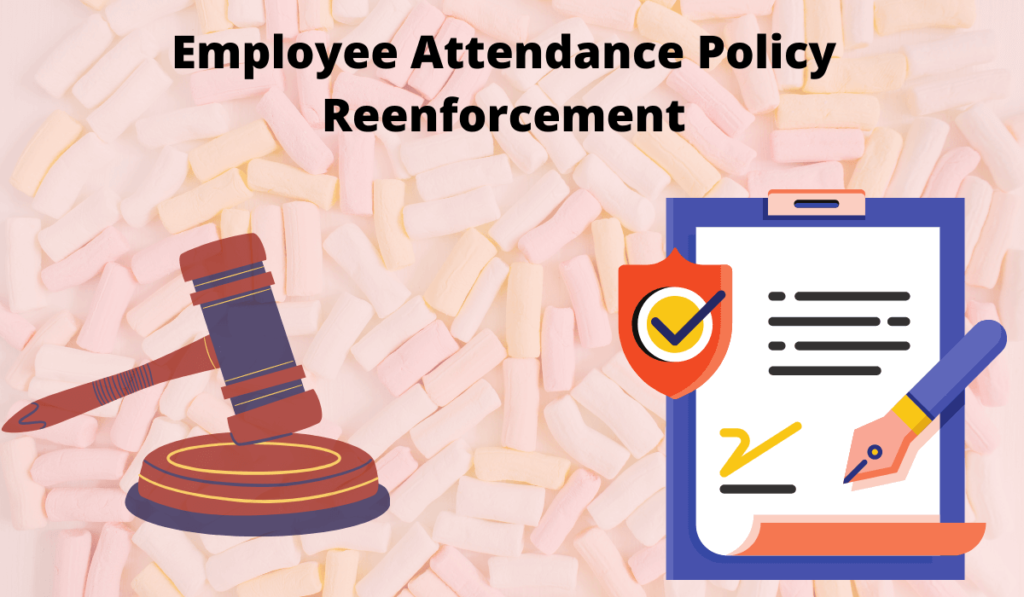Creating an Employee Attendance Policy

Are you looking for a new employee attendance policy that will help reduce the amount of time your employees are absent? As an HR Professional, do you face newer issues about the attendance policy in your organization? If so, you are in a good place and this blog post is written only for you. In this blog post, you will learn some of the best tips for creating an attendance policy that works best for your business.
We will also provide a few examples of policies that you can use as inspiration. So, whether you are just starting to create a policy or you are looking for ideas on how to improve your current policy, read on. In addition, we will discuss best practices and offer some examples of policies you can use as inspiration when designing yours.

What Is An Attendance Policy And Why Do You Need One?
In your college course, you might have read about employee attendance or you might have seen it in your office for the first time when you started your job. Did I guess right? So, to increase your professional knowledge keep reading this blog post.
Before reading about the attendance policy, let’s know what a policy is? A policy is a set of rules that an organization creates to guide employee behavior. It is usually available in the office in a document. So, the employee attendance policy is a set of rules that guide employee behavior regarding their attendance.
You might also ask yourself why organizations need any policy? It is a good question of course. Organizations need to create a policy because it sets expectations for employee behavior and it provides consequences for employee misconduct. It communicates the expectations and employees try to meet the same. Additionally, having a policy in place can help you manage employee absences more effectively and efficiently.
An attendance policy is a set of guidelines that dictate when and how often employees are allowed to be absent from work. The purpose of these policies is to promote employee productivity and attendance. Having an employee attendance policy in place can also help you to identify and address any attendance issues that may be affecting your business.
Things To Keep In Mind
Creating any company policy takes considerable time and effort and the attendance policy has no exception. You need to consider many things while writing an attendance policy. So, there are a few key things to keep in mind when creating an effective attendance policy:
Types of Absences:
First, you will need to decide what types of absences will be allowed. For example, you may allow employees to take paid vacation days, but not unpaid sick days. The frequency of the type of absences also needs to be considered.
Attendance Expectations:
You will also need to set clear expectations for employee attendance. For example, you may require employees to notify their supervisor if they will be absent for more than two days. This is one of the utmost important work ethics as well. When you communicate about your absence then your supervisor manages another employee in your place and the work is performed smoothly.
Handling Employee Absences:
Finally, you will need to decide how you will handle employee absences. For example, you may have a point system in place that tracks employee absences. If an employee reaches a certain number of points, they may be subject to disciplinary action. You might have seen that employees are entitled to a specific number of leaves; Sick Leaves, or Casual leaves at the beginning of the year.
Now that we have covered the basics, let’s take a look at how to write an attendance policy.
How To Write An Attendance Policy?
According to the Society of Human Resource Management (SHRM), for most businesses, employee absenteeism is a major problem. In 2017, the Department of Labor (DOL) predicted that around 3% of an organization’s employees were unable to report for work on any given day. Even more so, when productivity, morale, and temporary labor expenditures are taken into account, the high cost of absenteeism has an impact on firms.
Therefore, writing an employee attendance policy is very important and it must be written with great care. When writing an attendance policy, there are a few key elements that you will need to include:
A Statement of The Company’s Attendance Policy Expectations
As a Human Resource professional, you will have to set expectations for employee attendance. For example, you may require employees to notify their supervisor if they will be absent for more than two days. This expectation makes it clear to the employee that he or she needs to communicate his/ her absence.
A Description Of The Types of Absences That Are Allowed
There might be different types of absences employees make in an organization. You will need to decide what types of absences will be allowed. For example, you may allow employees to take paid vacation days, but not unpaid sick days. The frequency of the type of absences also needs to be considered.
Paid Vacations Days: Paid vacation days are the employee’s entitlement to paid time off work. An employee is typically entitled to a certain number of paid vacation days per year, depending on their length of service.
Do you want to ask why paid vacations are allowed? Paid vacation days are given to employees to encourage employee productivity and attendance. Having paid vacation days motivates employees towards greater productivity because they perceive that organization values their contribution.
Unpaid Sick Leaves: Unpaid sick days are the employee’s entitlement to take time off work due to illness or injury. An employee is typically entitled to a certain number of unpaid sick days per year, depending on their length of service.
Including these types of absences in your attendance policy is important.
Important to remember that in the U.S, the Family and Medical Leave Act (FMLA) states that an employer cannot require a doctor’s note for an employee to take unpaid sick leave.
Paid Vacation Days: You will have to consider the employee’s role in the company and how long he/ she has been with the organization.
A Description of The Consequences of Violating the Attendance Policy
A company’s attendance policy is a legal document. To make your attendance policy, it is important to include a section on the consequences of violating the attendance policy. This will let employees know what they can expect if they violate the policy.
For example, you may have a point system in place that tracks employee absences. If an employee reaches a certain number of points, they may be subject to disciplinary action.
Another example would be if an employee is absent for more than two days without notifying their supervisor, they may be subject to disciplinary action.
This section is important because it sets clear expectations for employee attendance and lets employees know what they can expect if they violate the policy.
A Description of The Employee’s Responsibility to Notify Their Supervisor of An Absence
This section of the employee attendance policy should make it clear that it is the employee’s responsibility to notify their supervisor of an absence whether it is a sick leave or casual.
For example, if an employee is going to be absent for a doctor’s appointment, they need to let their supervisor know in advance.
This way, the supervisor can make arrangements for coverage. If an employee does not notify their supervisor of an absence, it may be considered a violation of the attendance policy. You can see the employee attendance policy template as well.
The Frequency of The Type of Absences:
HR manager is responsible to identify the unexcused or unreported absence of an employee. The frequency of the type of absences really matters when it comes to the employee attendance policy.
If an employee is absent more than the allowed number of times, they may be subject to disciplinary action. The employee attendance policy should make it clear what the consequences are for violating the policy.
For example, if an employee is absent without an approved leave, unexcused and unreported absences, they may be subject to a written warning. In this way, they also violate the scheduled shift.
After a certain number of violations, the employee may be subject to more serious disciplinary action, up to and including termination. Most importantly, it is important to note that attendance policies should be applied consistently to all employees.
How employee absences will be handled?
Research studies show that employee frequent absences can have a negative impact on organizational performance. You can see the effect it has on your company’s bottom line, finances, and productivity.
Get more out of your business
Get the best employee engagement content every week via mailing list
What is a reasonable attendance policy?
This heading seems reasonable, right? A reasonable attendance policy is one that takes into account the needs of both the employer and the employee.
The employer needs to have enough staff on hand to meet the demands of the business by ensuring regular attendance, and the employee needs to be able to take care of their personal responsibilities. A good attendance policy will strike a balance between these two needs.
By including these elements in your employee attendance policy, you will be able to set clear expectations for employee attendance and identify how absenteeism will be dealt with.
Below is an example of an employee attendance policy, you can also download the employee attendance policy template for more clarity of the concept. The points of the policy are as under:
- “It is the policy of [company name] that all employees are expected to maintain a regular and consistent attendance record. Employees are expected to notify their supervisor if they will be absent for more than two days.
- Vacation days and sick days are the only types of absences that are allowed. Employees are allowed to take a maximum of [number] vacation days per year. Sick days are limited to [number] days per year.
- If an employee exceeds the number of allowed absences, they may be subject to disciplinary action. Disciplinary action may include, but is not limited to, a verbal warning, written warning, or termination of employment.”
By including these elements in your employee attendance policy, you will be able to set clear expectations for employee attendance and identify how absenteeism will be dealt with.
Types of Absences:
While tracking attendance, you will come to know about different types of absences. The most common ones are:
Vacation :
If you are getting paid vacation days, you must be thankful and should enjoy the paid leaves or paid absence. Paid vacation days are a great way to encourage employee productivity. This type of absence is typically allowed with little to no restrictions.

Sick Days:
Have you been absent pretending that you are sick? I guess you had done last month. Sick days are a necessary part of any company attendance policy. However, you may want to consider placing some restrictions on taking excessive sick leave or reducing weekly work hours.
For example, you may require employees to submit doctor’s notes if they are absent for more than two days. Otherwise, regular attendance might be at risk due to an unexcused absence.
Personal Days:
Personal days are an excellent approach to allow workers to handle personal matters without using vacation or sick days. However, you may want to limit the number of personal days that an employee can take in a year to ensure that the scheduled shift is smoothly working.
Bereavement:
Bereavement leave is typically allowed for the death of an immediate family member. However, you may want to consider allowing employees to take this type of leave for other significant losses, such as the death of a pet. As a human resource manager, you should maintain a list of approved absences in a payroll timekeeping system.
Paternity/Maternity:
Paternity and maternity leave are important for new parents. You may want to consider offering this type of leave to both mothers and fathers.
Jury Duty:
Jury duty is a civic responsibility in which citizens are chosen at random to serve on a jury. If you are an employee who has been summoned for jury duty, you may be wondering if you will still get paid.
Work From Home:
In today’s technology-driven world, more and more employees are working from home. If you allow your employees to work from home, you will need to develop a work from home policy. This type of policy will outline the expectations and procedures for working from home.

Unpaid Leave:
Unpaid leave is typically allowed for employees who have exhausted their vacation and sick days. This type of leave is typically used for extended absences, such as maternity leave.
Now that we’ve covered the types of absences that you may want to include in your employee attendance policy, let’s take a look at how to write the policy.
Elements of a good employee attendance policy
As you know well that an employee attendance policy is a set of rules and guidelines that dictate when and how often an employee can miss work. A good employee attendance policy will be clear and concise, easy to understand and follow, and fair to all employees.
There are a few key elements that should be included in every employee attendance policy:
- A definition of what is considered an “absence”
- The consequences for excessive absences
- The process for requesting and approving absences
- The attendance policy for shift workers
- A section on tardiness and early departures
- A section on employee leave, including vacation days, sick days, and personal days
How to enforce your employee attendance policy
“Workers regard the attendance policy as a draconian measure that makes no sense except as an effort to get every employee to quit out of rage, depression, or ill health.”

Once you have created your employee attendance policy, it is important to enforce it fairly and consistently as it is a legal liability to the employees. Employees who violate the attendance policy should be disciplined in the same way, regardless of their position or seniority.
If you have an employee who repeatedly violates the attendance policy, you may need to take more serious disciplinary action, up to and including termination.
Enforcing your employee attendance policy can be difficult, but it is important to do so to maintain a productive and positive work environment.
Fair Enforcement:
Fairness is important in every field of life. If you will not be fair in terms of employee attendance then your policy is nothing more than a piece of paper. All employees should be treated equally when it comes to attendance policy violations.
Consistent Enforcement:
The attendance policy should be enforced consistently, without exception. This means that all employees who violate the policy should be disciplined in the same way, regardless of their position or seniority. It should be consistently communicated through employee handbook so that each employee has complete knowledge of the same. Following a policy is a legal liability on the employee.
Progressive Discipline:
Progressive discipline is a process of increasing the severity of the consequences for each successive violation of the attendance policy.
For example, an employee who violates the attendance policy for the first time may receive a verbal warning. If they violate the policy again, they may receive a written warning. The third time they violate the policy, they may be suspended without pay. And if they violate the policy a fourth time, they may be terminated.
Terminations should always be a last resort and only used in cases of repeated or severe violations of the attendance policy.
Common issues with employee attendance policies
Despite clearly mentioning the policy and sharing it with your employees through the employee handbook, as an HR manager, you will face some common issues with attendance policies:
- One of the most common problems with employee attendance policies is that they are often too vague. This can lead to confusion and frustration on the part of both employees and managers.
- Another common issue is that attendance policies are often not enforced consistently. This can lead to resentment and mistrust among employees.
- It is important to avoid these pitfalls when creating and enforcing your employee attendance policy.
- Keep your attendance policy clear and concise, easy to understand and follow, and fair to all employees.
- Enforce your attendance policy fairly and consistently, without exception.
- Use progressive discipline when necessary, but always reserve termination for cases of repeated or severe violations.
By following these tips, you can create an employee attendance policy that will help to maintain a productive and positive work environment.
What are Employee Attendance Infractions?
There are many different employee attendance infractions. Some of the most common include:
Tardiness: This happens when someone comes to work late without permission or a reasonable explanation.
Early Departure: An employee who leaves work early without obtaining prior approval or a legitimate reason is known as a “sneak.”
Absence: This is referred to as a no-show. When an employee does not report for work without prior permission or a reasonable explanation, it’s known as an absence.
Extended Leave: An extended leave is when an employee takes more time off than what is allowed in the attendance policy. This could be for personal reasons or due to illness.
Unauthorized Leave: This is when an employee takes time off without prior approval from their manager.
Just, ask yourself which one you do usually from the above-mentioned attendance infractions? Be honest!y optimized content goes here!
Conclusion
We discussed everything about the employee attendance policy, its importance, strategies, and elements of a good employee attendance policy. Further, you saw the employee attendance policy template. It is important to have a policy in place for employee absences. The best way to handle employee absences is to have a policy that is easy to understand and flexible enough to accommodate the needs of your employees.


